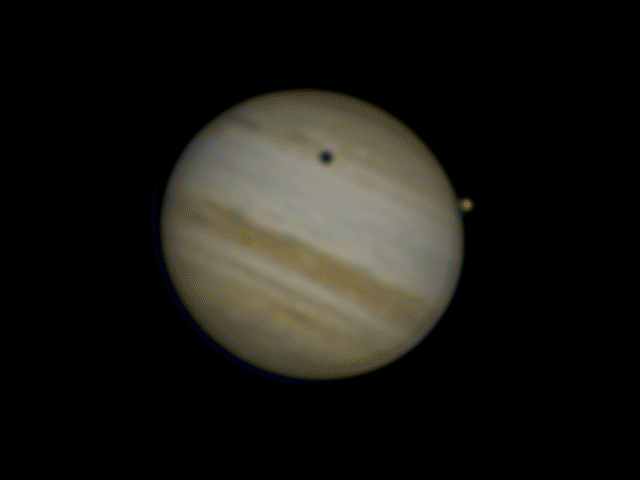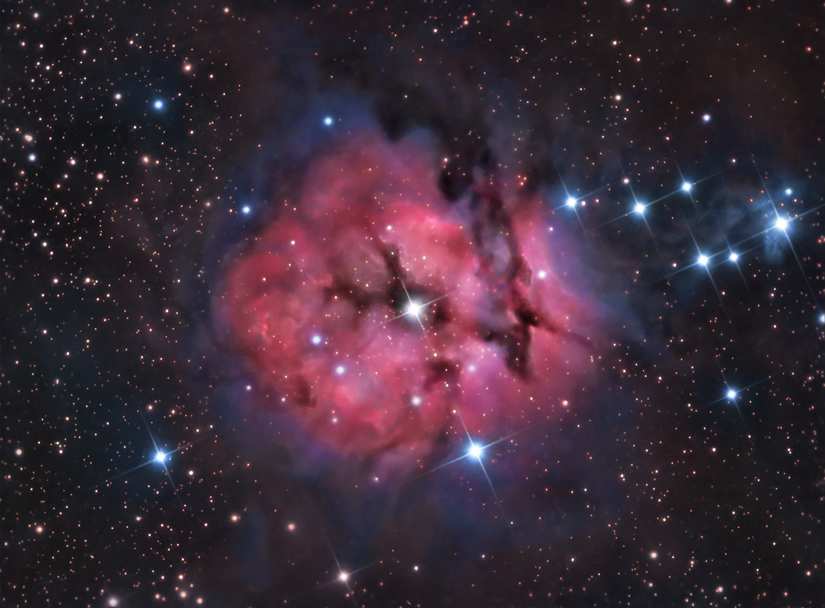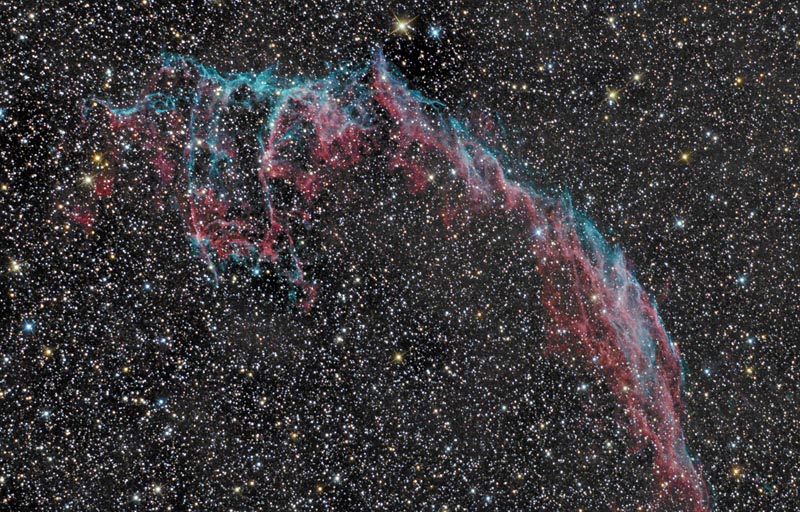Recent Submissions: 2010 September 11-13
Recent Submissions: 2010 September 11-13
_____________________________________________________________________________
Please click on each image for best viewing; please click on the link below the
image title for more information about the image. Thank you!
_____________________________________________________________________________
<- Previous submissions
IC 63
http://www.caelumobservatory.com/gallery/ic63.shtml
Copyright and credit: Adam Block/Mount Lemmon SkyCenter/University of Arizona Ganymede Transit of Jupiter
http://www.markshelley.co.uk/Astronomy/ ... 2010v2.gif
Copyright: Mark Shelley Zodiacal Light
Copyright: Mojtaba Moghadasi
[attachment=3]zodiac light.jpg[/attachment][/i]
Sh2-132
http://www.astrosurf.com/gouveia
Copyright: Carlos Gouveia
[attachment=2]Sh2-132.jpg[/attachment][/i]
IC5146: Cocoon Nebula in Cygnus
http://helixgate.net
Copyright: Mike Siniscalchi Night Sky
Copyright: Loukas Hapsis
[attachment=1]EasterIsland_Hapsis.jpg[/attachment][/i]
Jupiter Rules!
Copyright: Tunç Tezel
[attachment=0]Jupiter Rules.jpg[/attachment][/i]
<- Previous submissions
Please click on each image for best viewing; please click on the link below the
image title for more information about the image. Thank you!
_____________________________________________________________________________
<- Previous submissions
IC 63
http://www.caelumobservatory.com/gallery/ic63.shtml
Copyright and credit: Adam Block/Mount Lemmon SkyCenter/University of Arizona Ganymede Transit of Jupiter
http://www.markshelley.co.uk/Astronomy/ ... 2010v2.gif
Copyright: Mark Shelley Zodiacal Light
Copyright: Mojtaba Moghadasi
[attachment=3]zodiac light.jpg[/attachment][/i]
Sh2-132
http://www.astrosurf.com/gouveia
Copyright: Carlos Gouveia
[attachment=2]Sh2-132.jpg[/attachment][/i]
IC5146: Cocoon Nebula in Cygnus
http://helixgate.net
Copyright: Mike Siniscalchi Night Sky
Copyright: Loukas Hapsis
[attachment=1]EasterIsland_Hapsis.jpg[/attachment][/i]
Jupiter Rules!
Copyright: Tunç Tezel
[attachment=0]Jupiter Rules.jpg[/attachment][/i]
<- Previous submissions
- Attachments
A closed mouth gathers no foot.
Re: Recent Submissions: 2010 September 11-13
Jupiter and Ganymede
http://picasaweb.google.com/jaume.castella
Copyright: Jaume Castellà
[attachment=2]20100904-Final + Dades.jpg[/attachment][/i]
vdB123 in Serpens
http://www.weatherandsky.com/Astronomy/ ... border.jpg
Copyright: Paul Mortfield and Kerry-Ann Lecky Hepburn
[attachment=1]vdb123_final_50percent_border.jpg[/attachment][/i]
Stars over Cade’s Cove
http://blackvisual.com
Copyright: Spencer Black
[attachment=0]starsovercadescove.jpg[/attachment][/i]
http://picasaweb.google.com/jaume.castella
Copyright: Jaume Castellà
[attachment=2]20100904-Final + Dades.jpg[/attachment][/i]
vdB123 in Serpens
http://www.weatherandsky.com/Astronomy/ ... border.jpg
Copyright: Paul Mortfield and Kerry-Ann Lecky Hepburn
[attachment=1]vdb123_final_50percent_border.jpg[/attachment][/i]
Stars over Cade’s Cove
http://blackvisual.com
Copyright: Spencer Black
[attachment=0]starsovercadescove.jpg[/attachment][/i]
A closed mouth gathers no foot.
Re: Recent Submissions: 2010 September 11-13
There were many nice images here! 
As for IC 63: Hi, Gamma Cas! Gamma Cas is one of my favorite stars (though I have many favorite stars). Gamma Cas is hot enough to produce IC 63, aren't we lucky?
And that's a great "spinning Jupiter" image! Jupiter spins so fast and is so massive that I think that up to 90% of the "rotational energy" of the Solar System is located in Jupiter! The Sun spins so slowly that it doesn't contribute much.
And even constellation Orion looks fresh and new when it is located sideways "looking down" on the zodiacal light!
And who can resist the Large Magellanic cloud when it has decided to pay the Easter Island statues a visit?
And the vdB123 in Serpens image is great! I love the colors, the different shades of blue as well as the dark browns and blacks and the orange nebula marking the spot where a brand-new star has not yet broken free of its natal cocoon.
Ann
As for IC 63: Hi, Gamma Cas! Gamma Cas is one of my favorite stars (though I have many favorite stars). Gamma Cas is hot enough to produce IC 63, aren't we lucky?
And that's a great "spinning Jupiter" image! Jupiter spins so fast and is so massive that I think that up to 90% of the "rotational energy" of the Solar System is located in Jupiter! The Sun spins so slowly that it doesn't contribute much.
And even constellation Orion looks fresh and new when it is located sideways "looking down" on the zodiacal light!
And who can resist the Large Magellanic cloud when it has decided to pay the Easter Island statues a visit?
And the vdB123 in Serpens image is great! I love the colors, the different shades of blue as well as the dark browns and blacks and the orange nebula marking the spot where a brand-new star has not yet broken free of its natal cocoon.
Ann
Color Commentator
Re: Recent Submissions: 2010 September 11-13
Ninth Messier Marathon in Iran
Copyright: Arman Golestaneh
[attachment=0]Messier Marathon.jpg[/attachment][/i]
Copyright: Arman Golestaneh
[attachment=0]Messier Marathon.jpg[/attachment][/i]
A closed mouth gathers no foot.
Re: Recent Submissions: 2010 September 11-13
A closed mouth gathers no foot.
Re: Recent Submissions: 2010 September 11-13
I had high hopes that the resident "color commentator" would be pleased to see this image. Rarely is this object captured at this resolution which helps show the variations in blue and pink/red. Unfortunately, you only commented on the star not even in the field!Ann wrote:There were many nice images here!
As for IC 63: Hi, Gamma Cas! Gamma Cas is one of my favorite stars (though I have many favorite stars). Gamma Cas is hot enough to produce IC 63, aren't we lucky?
-Adam
Re: Recent Submissions: 2010 September 11-13
Light Echoes Generated by the Variable stars S and R Corona Australis
http://icueva.wordpress.com/2010/09/10/3-meses/
http://www.aanda.org/index.php?option=c ... Itemid=129
Credit and copyright: IAA-CSIC, Astroimagen, CASLEO NGC 7000: North America Nebula
http://www.philippemoussette.com
Copyright: Philippe Moussette
[attachment=2]NGC7000_11sept10ST.jpg[/attachment][/i]
Comet Hartley 2
http://www.jwestlake.com
Copyright: Jimmy Westlake
[attachment=1]C_Hartley2 091110(sm).jpg[/attachment][/i]
Daylight Reappearance of Venus
Copyright: Maciej Soltynski
[attachment=0]Venus reappears.jpg[/attachment][/i]
http://icueva.wordpress.com/2010/09/10/3-meses/
http://www.aanda.org/index.php?option=c ... Itemid=129
Credit and copyright: IAA-CSIC, Astroimagen, CASLEO NGC 7000: North America Nebula
http://www.philippemoussette.com
Copyright: Philippe Moussette
[attachment=2]NGC7000_11sept10ST.jpg[/attachment][/i]
Comet Hartley 2
http://www.jwestlake.com
Copyright: Jimmy Westlake
[attachment=1]C_Hartley2 091110(sm).jpg[/attachment][/i]
Daylight Reappearance of Venus
Copyright: Maciej Soltynski
[attachment=0]Venus reappears.jpg[/attachment][/i]
A closed mouth gathers no foot.
- mexhunter
- Science Officer
- Posts: 467
- Joined: Tue Apr 27, 2010 1:41 pm
- AKA: César Cantú
- Location: Monterrey, Mexico.
- Contact:
Re: Recent Submissions: 2010 September 11-13
About Light Echoes Generated by the variable stars S and R Corona Australis, impressions rather than changes in the star, the displacement of the nebula.
Ignacio de la Cueva, one of the authors of this photo, said in another forum that the photo was made in three months, which much surprised by these changes so violent.
This is beyond photography as art, pure science is rather that someone should explain.
Greetings
César
Ignacio de la Cueva, one of the authors of this photo, said in another forum that the photo was made in three months, which much surprised by these changes so violent.
This is beyond photography as art, pure science is rather that someone should explain.
Greetings
César
I come to learn and to have fun.
Re: Recent Submissions: 2010 September 11-13
César, thanks for your post! The second link under the title for that image is to the published paper on these echoes. Very cool stuff!! (And beautiful, too.)
A closed mouth gathers no foot.
Re: Recent Submissions: 2010 September 11-13
Adam, sorry. It is a great color picture. A great thing about it is that it brings out how this gas cloud is partly ionised by Gamma Cas, so that it glows pink, but part of the gas blob is less ionised and glows blue from reflection. Note that the reddest part of the gas cloud is where the ultraviolet light from Gamma Cas is shining straight at it, that is to say at the star-facing edge of the cloud. Other parts of the cloud are shielded by the gas blob itself, and they are therefore blue rather than pink.ngc1535 wrote:I had high hopes that the resident "color commentator" would be pleased to see this image. Rarely is this object captured at this resolution which helps show the variations in blue and pink/red. Unfortunately, you only commented on the star not even in the field!Ann wrote:There were many nice images here!
As for IC 63: Hi, Gamma Cas! Gamma Cas is one of my favorite stars (though I have many favorite stars). Gamma Cas is hot enough to produce IC 63, aren't we lucky?
I will keep trying...
-Adam
Gamma Cas is right at the border where stars are hot enough to ionise nearby gas clouds. There is another gas cloud nearby which is barely ionised and mostly blue.
Ann
Color Commentator
- rstevenson
- Quis custodiet ipsos custodes?
- Posts: 2705
- Joined: Fri Mar 28, 2008 1:24 pm
- Location: Halifax, NS, Canada
Re: Recent Submissions: 2010 September 11-13
The image "Light Echoes Generated by the Variable stars S and R Corona Australis" is absolutely astonishing. It's one thing to imagine a light echo from a description. It's quite another to see it happening in the image. This one is going to be standing on the podium for APOD of the year, I'm sure. (But it has to become an APOD first -- hint.)
Rob
Rob
Re: Recent Submissions: 2010 September 11-13
Silly me! I didn't even realize that "Light Echoes Generated by the Variable stars S and R Corona Australis" is a picture that "moves", that is, a picture that shows actual changes of light!
I agree, it is a fantastic image.
Ann
I agree, it is a fantastic image.
Ann
Color Commentator
Re: Recent Submissions: 2010 September 11-13
I agree with you Rob.rstevenson wrote:The image "Light Echoes Generated by the Variable stars S and R Corona Australis" is absolutely astonishing. It's one thing to imagine a light echo from a description. It's quite another to see it happening in the image. This one is going to be standing on the podium for APOD of the year, I'm sure. (But it has to become an APOD first -- hint.)
Rob
A worthy APOD candidate and a Prominent APOD OTY suspect
- mexhunter
- Science Officer
- Posts: 467
- Joined: Tue Apr 27, 2010 1:41 pm
- AKA: César Cantú
- Location: Monterrey, Mexico.
- Contact:
Re: Recent Submissions: 2010 September 11-13
Hello Owlice:
Thank you very much, I've seen.
Also asked Ignacio de la Cueva, and has given me an extraordinary explanation in Spanish, which helped me to understand that matter is not expanding, only light, and it is these intermittent pulses of both stars away from them.
Of course the explanation is more complete, understandable and fascinating.
Regards
César
In case anyone wants to read in Spanish:
Thank you very much, I've seen.
Also asked Ignacio de la Cueva, and has given me an extraordinary explanation in Spanish, which helped me to understand that matter is not expanding, only light, and it is these intermittent pulses of both stars away from them.
Of course the explanation is more complete, understandable and fascinating.
Regards
César
In case anyone wants to read in Spanish:
per Google tranlsateHola César,
Gracias por tus amables comentarios. En cuanto al movimiento del entorno, ciertamente merece una explicación mas concisa, debe quedar claro desde el principio que lo que se ve en las imágenes no es expansión de materia, solo de luz, y que son estos pulsos intermitentes de ambas estrellas los que se alejan de sus estrellas progenitoras iluminando mas intensamente estructuras estelares a su paso. Dicho esto, en el caso de la estrella S, la que pulsa a la derecha, el entorno de materia que refleja los ecos tiene un tamaño de 10000 UAs, o lo que es lo mismo, unas pocas semanas luz, por tanto, en el espacio de 3 meses da tiempo a que la luz recorra la esfera en mas de una ocasión si la estrella pulsa varias veces. En el caso de R, la estrella inmersa en NGC6729, la nebulosidad asociada en sus proximidades y que es iluminada en forma parecida a algo que describiría como una 'cola cometaria' que se pierde por la izquierda, según mis calculos, tendría en su eje longitudinal del orden de 7-8 meses luz, por tanto, un pulso originado en la estrella llegaría a los confines de la cola en ese tiempo y por tanto, el 'bandeo' que se ve por toda la cola no tendría mucha lógica de no ser porque.... R pulsaba por aquel entonces a un ritmo bastante constante de unos 35-40 días (eso si, con diferentes intensidades maximas en cada ocasión), por tanto, en realidad y aunque la animación contempla 3 meses de tiempo vs velocidad luz, hay ecos lejanos de R que pertenecen a pulsos emitidos por R antes de las primeras fotografías y cuyos frentes de onda ya llevaban meses viajando mientras otros les seguían despues originados por pulsos mas recientes, en definitiva, un tren de ondas causado por una fuente repicando cada 30-40 días, por eso la cola ondea como lo hace. En el caso de S, sus pulsos también eran por aquel entonces y curiosamente de unos 30 días y casi sincronizados con R, pura casualidad, no hay relación, pero en el caso de S, al estar su materia confinada en unas poquitas semanas luz, cada pulso nuevo corria toda la 'nube de oort' en un mes y vuelta a empezar. A mi me parecio fascinante, y hoy, cuanto mejor conozco esta región, mas me lo parece, permitiendo dar rienda suelta a la imaginación. Tengo material adicional de 2009 que espero poder publicar pronto, es la milk!. A todo esto, como esta región esta a 'solo' unos 138 pc ó 450 A.L., un día luz mide aparentemente cerca de 2", algo medible por instrumentos de aficionado, y lo que daría por que el Hubble las visitara, comprenderme, son mis 'criaturas'
Un abrazo
Ig.
Thank you for your kind remarks. As for the environmental movement, certainly deserves a more concise explanation, it should be clear from the outset that what you see in the image field is not expanding, only light, and it is these intermittent pulses which both stars away from their parent stars more intensely illuminating stellar structure in its path. Having said that, in the case of the star S, which hit the right field environment that reflects the echoes has a size of 10000 UAs, or what is the same, light a few weeks hence in space of three months allows time for the light to travel the area in more than one occasion if the star pressed repeatedly. In the case of R, the star embedded in NGC6729, the cloudiness associated in its vicinity and that is illuminated in a manner similar to something I would describe as a 'comet tail' that misses to the left, according to my calculations, would have on its axis longitudinal order of 7-8 months of light, therefore, a pulse originating from the star would reach the ends of the queue at that time and therefore the 'banding' that is seen throughout the tail does not have much logic be because .... R strummed by then a fairly steady pace of about 35-40 days (when they, with different intensity on each occasion), so in fact and although the animation includes 3 months of time vs speed of light, there are distant echoes R which belong to R pulses emitted by the first photographs before and whose wave fronts and traveling while others took months after they were caused by pulses more recent ultimately, a train of waves caused by a source ringing every 30-40 days, so the tail waving as he does. In the case of S, their pulses were also curious at the time and about 30 days and almost synchronized with R, pure coincidence, no relation, but in the case of S, being confined to their stuff a weeks delicated light each pulse again ran all the 'Oort cloud' in a month and back again. I thought it was fascinating, and today, the better I know this region, but it seems to me, allowing free rein to the imagination. I have additional material from 2009 that I hope to publish soon, is the milk!. In all this, as this region is to 'only' about 138 pc or 450 AL, a day seemingly light measures about 2 ", something measurable by amateur instruments, and that would give Hubble the visit, understand and are my 'creatures'
I come to learn and to have fun.




